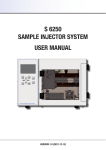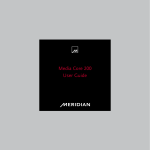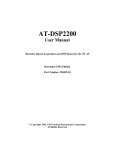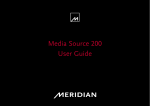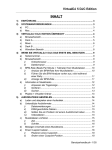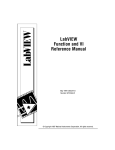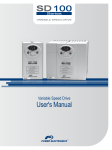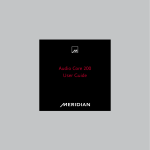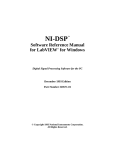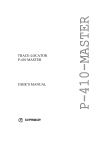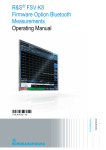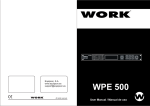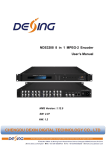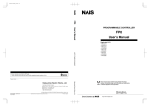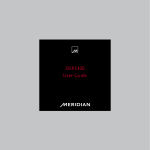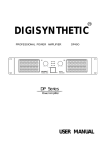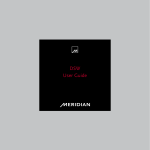Download DSP DSPE SERIES.cdr
Transcript
R DIGISYNTHETIC INTEGRATED DSP POWER AMPLIFIER E SERIES PROFESSIONAL AMPLIFIER DSP4800 DSP3200 DSP2240 DSP1800 DSP1400 DSP2200 DSP1200 DSP4800E DSP3200E DSP2240E DSP1800E DSP1400E DSP2200E DSP1200E USER MANUAL IMPORTANT SAFETY INSTRUCTION WARNING When using electric products, basic precautions should always be followed: 1. Read all the SAFETY INSTRUCTIONS before using the product. 2. This product must be earthed. If it has malfunction or breaks down, grounding provides a path of least resistance for electric current to reduce risk of electric shock. This product is equipped with a cord having an equipment-grounding conductor and a grounding plug. The plug must be plugged into an appropriate outlet that is properly installed and earthed in accordance with all local codes and ordinance. DANGER - Improper connection of the equipment-grounding conductor can result in a risk of electric shock. Check with a qualified electrician or serviceman if you are in doubt as to whether the product is properly grounded. Do not modify the plug provided with the product - if it will not fit the outlet, have a proper outlet installed by a qualified electrician. 3. To reduce the risk of injury, close supervision is necessary when the product is used near children. 4. Do not use this product near water - for example, near a bathtub, washbowl, kitchen sink, in wet basement or near a swimming pool or the lake. 5. This product may be capable of producing sound levels that could cause permanent hearing loss. Do not operate for a long period of time at high volume level or at a level that is uncomfortable. If you experience any hearing loss or ringing in the ears, you should consult an audiologist. 6. This product should be located so that its location or position does not interfere with its proper ventilation. 7. This product should be located away from heat sources such as radiators, heat registers or other products that produce heat. 8. The product should be connected to a power supply only of the type described on the operating instructions or as marked on the product. 9. This product may be equipped with a polarized line plug (one blade wider than the other). This is a safety feature. If you are unable to insert the plug into the outlet, contact an electrician to replace your obsolete outlet. Do not defeat the safety purpose of the plug. 10. The power-supply cord of the product should be unplugged from the outlet when left unused for a long period of time. When unplugging the power-supply cord, do not pull on the cord, but grasp it by the plug. 11. Care should be taken so that object do not fall and liquid are not spilled into the enclosure through openings 12. The product should be serviced by qualified service personnel when: A. The power-supply cord or the plug has been damaged; B. Objects have fallen, or liquid has been spilled into the product; C. The product has been exposed to rain; D. The product does not appear to operate normally or exhibits a marked change in performance; E. The product has been dropped or the enclosure damaged. 13. Do not attempt to service the product beyond that described in the user-maintenance instructions. All other servicing should be referred to qualified service personnel. WARNING - Do not place objects on the product's power cord or place it in a position where anyone could trip over, walk on or roll anything over it. Do not allow the product to rest on or to be installed over power cords of any type. Improper installations of this type create the possibility of fire hazard and/ or personal injury. 1 Installation & operating instruction Mains power connection. Before connecting the amplifier to the mains power socket, make certain that the voltage corresponds with that indicated on the rear of the unit (an allowance of 10% is acceptable). Before connecting the power cable to the mains, always make certain that it is not damaged and that there are no bare wires, always connect the power cable to the amplifier before switching it on and only remove the cable after switching it off. Switching on and off. In an audio system, it's always better to switch power amplifiers on last and off first. Remember to switch off the amplifier before connecting it to or disconnecting it from other units and to switch always on first the mixer and then the amplifier: in this manner, peaks which are annoying and sometimes dangerous particularly for the loudspeakers enclosures are avoided. It is normal for the LEDs to light up for a few moments when switching on. Handling. Do not force knobs and connectors, as they could be damaged if treated with excessive force. Connections and prevention of possible interference. Avoid installing your equipment near radios, televisions, etc., since they could cause noisy disturbance. When connecting the other units in your sound system, watch out for to socalled earth-loops, which can cause hum: in the event of interference, try using the EARTH switch on the amplifier's rear panel. Connector cables. To connect the amplifier to the mixer, always make certain to use only signal cables (screened cables made up of two wires plus a braid screen), not power cables (speaker cables, normally made up of two wires, usually with a greater cross-section): to connect the amplifier to the loudspeaker enclosures, always use power cables, not signal cables, as in the latter case in fact, the power from the amplifiers would be partially disperse because of the cable's smaller cross-section. Take care of the connector cables. Always hold them by the connectors, avoiding pulling the wire and avoid knots and twists when coiling them: this gives the advantage of increasing their life and reliability. Air circulation for cooling. Amplifier's correct cooling is ensured by an internal fan, the speed of which is controlled by a special sensor (the speed is proportional to output power and therefore the temperature generated):remember never to block the air vents located on the unit's sides in any way: the air necessary for cooling passes through these. If the amplifier is kept in a flight-case during use, make certain that it has sufficient openings at both the amplifier's air vents. Avoid locating it very small spaces which don't allow correct air circulation. 2 FEATURE Integrated system ? Perfect electronic protections: short circuit/overload protection, overheating protection and direct current excursion protection. ? Network control ? Built-in 48-bit DSP processor and dynamic range up to 116dB, 48kHz sampling rate A/D, D/A, ? Low noise and lower distortion ? Well-designed signal generator: sin wave and white noise ? S/PDIF input/output ( option) ? Matrix control, up to 255 units controlled by selecting address code ? Save and recall all parameters via PC parallel port ? 3 bands PEQ, limiter(threshold, attack time and release time adjusted), delay(max 8ms), phase invert, input gain control ? Two crossover, range: 20Hz-20kHz. Crossover frequency adjusted. Slope: -6, - 12, -18, -24 AND 48dB Butterworth, Linkwitz-Riley filter ? Three output modes: stereo, mono and bridge(only for DSP1400,DSP1400E, DSP2200E,DSP1200E) ? THD+N: 0.08%@1kHz ? Frequency response: 20Hz-20kHz ? 2 20 LCD display with backlit 3 CONTROL PANEL A. FRONT PANEL 1 5 1 3 2 5 2 4 6 3 64 1. CHA : Adjust the volume of channel A CHA /C: Adjust the volume of channel A/C(only for DSP4800 & DSP4800E) 2. CHB : Adjust the volume of channel B CHB /D: Adjust the volume of channel B/D(only for DSP4800 & DSP4800E) 3. INPUT INTERFACE TO PC 4. OUTPUT INTERFACE TO PC 5. 2 20 LCD DISPLAY WITH BACKLIT 6. POWER: ON/OFF Note: Press the rotar y encoder(1,2) to switch between the CHA/B and CHC/D. 4 B. REAR PANEL 1 CH.B IN BA LAN CED 0d B 30 K OH M 2 OTUPUT IMPE DANCE CH.A IN OHM OHM 16 8 OH M OH M BAL ANC ED 4 OHM 4 OH M 0dB PI N1+ 2: + PI N1-1 -: - L I NK CH.A OUT CH.B OUT + - LINK POWER INPUT + L INK 4 - 30K OHM PIN1 +2: PIN1 -1-: + - LIN K SERIAL No EARTH A C2 30V 10% 50 6 0 Hz 5 OTU PUT 16 8 IM PED ANC E 3 1. Balanced input(odB/30kOhm): For all the models, both CHA and CHB have one pair of balanced input with cannon connector. 2. Power output: output should be connected to the loudspeaker. The CHA/CHB outputs of DSP series amplifier have one waterproof jack and one group of binding post. Note: The rated power and the impedance load of loudspeaker or loudspeaker system must match the amplifier(see technical specification). Please use the speaker cable only(normally provided with one red and one black wire). Do not use the signal cable( normally used for microphone and audio equipment). 3. Earthed ON/FLOATING Separate the signal earth from the chassis. Using this selector to break earth loops which can form when several units are connected. 4. Power: AC 230V 10% 50-60Hz. 5. Air vents Note: The fan of the DSP series cooling system creates a flow of air with the direction from front to back. That means the air is taken from the opening on the front and is expelled through the opening on the front after cooling the heat sinks and transformer. Attention must be paid to avoid blocking these openings. And never place the amplifier in which there is not sufficient air circulation. 5 OPERATION INSTRUCTION I: OFF LINE M ODE: Switch on the power, the system accesses the OFFLINE mode. A. Adjust the volume: turn CHA/CHB button to adjust the input level of CHA/CHB. B. Setup the amplifier ID: Press CHA button for about 3 seconds, the LCD shows as follows: SET UP AMPLIF IER DEVICE ID NO.#1 Amplifier ID Then, turn CHA to change the amplifier ID from 1 to 255. Press CHA button again and save the setting. C. Load program Press the CHB button for about 3 seconds, the LCD shows as follows: LOAD PROGRAM P :11 NO PEQ+XOVER+DELAY Program Number Program name Then, turn CHA to select one program(1-11) . Press CHB button again, save the setting and load the selected program. At the same time, the LCD shows: LOADING ..........Several seconds later, the LOADING is finished and the system return the menu D. SETUP VOLUME PROTECT Under the menu of LOAD PROGRAM , press the CHB button again for about 3 seconds and then the LCD shows as follows: VOLUME MUTE PROTECT AUTO MUTE: ON Turn the CHB button to switch on/off AUTO MUTE. Then, press the CHB button again to save the setting. AUTO MUTE: ON. When the power is on, the volume of CHA/CHB is MUTE automatically. AUTO MUTE: OFF. When the power is on, the volume of CHA/CHB comes to the setting when power was off last time. NOTE: 1.Among 11 programs, No.11 is not used under the online mode without PEQ, XOVER and DELAY. The other 10 programs can be saved and recalled on the online mode. 2. The volume is mute automatically after ever y LOAD PROGRAM. 3. When the system switches from the online mode to the offline, the system can load the program that is saved under th online mode. At the same time, the volume is mute automatically. 6 II: ONLINE M ODE 1. Connect the amplifier to PC with the right cable: insert one end ot cable into parallel port of PC and the other end into the PC REMOTE in the front panel of amplifier. Start DSP6 testing software. 2. CONNECTION Click the Debug button and then click Connect. Select one device number(1255). If this number is the same as the amplifier ID, the LCD shows as follows: CONNECT SUCCESSFUL PC_CONTROL DEVICE At that time, the system can be tested by DSP6 software. All the functions under the offline mode is not valid. . 3. DISCONNECT Click Debug button and then click Disconnect, the LCD shows as follows: CONNECT CANCEL MCU_CONTROL DEVICE Then the software testing is not valid. The system return the offline mode. Regarding the operation of DSP6 software, please refer to the online help of it. DIGISYNTHETIC #1 R R POWE R DSP3200 PC RE MOTE I NPUT 48KH zSAMPLING RATE CHA OU TPUT POWER CHB R DSP3200 24BI T DSP STE REO POW ER AMPL IFI E R PC REMOTE INPUT 48KHzSAMPLI NGRAT E CHA OUTPUT CHB 24BI T DSPST ERE OPOW ER AMPLI FI ER DIGISYNTHETIC #3 PC REMOTE INPUT 48KHzSAMPLI NGRAT E CHA DIGISYNTHETIC #2 DSP3200 24BI T DSP STE REO POW ER AMPL IFI E R CHB OUTPUT POWE R 7 III. PC SOFTWARE OPERATION The software adopts the advanced telecommunication control technology. The user can control the gain, EQ, crossover, delay, limiter, program management etc. through the interface software. The below introduces establish the connection and program management operation. A. Establish the connection 1. Installing the Software Run the application <>. Setup will install the DSP6 application onto your PC. You can accept the default director y, or specify a different location to install the application. 2. Connecting a PC Use a standard computer cable (accessor y with the unit) to connect a PC to the DSP amplifier. 3. Configure COM port Click on Tools in the top menu bar, and select COM Setup... to open the COM Setup window. The application uses COM1 on the PC by default. If necessar y, you can change the COM port used by the application. Click the COM Select: COM1 pulldown box in the COM Setup window, all the serial ports available in the PC list automatically, then select the desired COM port and click OK button. Select Search...to open search function that will find out all the units in the net. The multiple units with the same Address (master ID) and different Sub Address (slave ID) can not be identified. You can identify such units only from the Sub Address (slave ID), please keep the Sub Address (slave ID) so that you can control such units when connecting with PC 8 4. Establish the Communication Connect Select Connect button to open the Connect window. Fill in the Add and/or Sub Add to select the unit. Click Connect to go online , , Then you can adjust the amplifier s parameters of gain,EQ, crossover, delay, compress/limit, mode etc.. The Address (main ID) is from 1 to 255 that can be setup by the user freely. The Sub Address (slave ID) is from 1 to 65536 that is preset in the factor y and can ' t be changed. The Sub Address will display each time the unit powers on or press the left jog-wheel after turning on. The unit is mute (default) if mute is selected by clicking the MUTE checkbox, otherwise the unit gain remains. Disconnect means the unit connecting goes out of the PC control. The unit will reload the program automatically while disconnect. The gain will escalate gradually up to the program gain if the program gain is not mute and AUTO MUTE is OFF (refer to SETUP VOLUME PROTECT in amplifier manual). NOTE: The user must fill in Sub Add (slave ID) to connect the unit if two or above units with the same Add (master ID). Otherwise the system would connect all the units with the same Add (master ID) to cause communication malfunction. If no units have the same Add (master ID), the user can connect the units without Sub Add (slave ID) setup. The present connect unit disconnects automatically every time connecting a new unit. 9 Click Device button to open the Device window. The user can modify the Name of the unit and manage the device information before connect. The maximum units can be managed are 255. Select a device, click OK button, the device information will be sent to the Connect window. B. Program Management A program can be stored in any one of the 20 available memor y locations. The No. 21program is a default one, who can ' t be refreshed, EQ and Limiter cur ve is smooth. No delay. The phase is zero. Refresh: Write the current program content into the unit. The "[###]" symbol indicates there are setup parameters in program. Vice versa. Upload: Recall the program, and setup the program number as the current one, mute and pass the parameters to the PC program interface. 10 File Down: Download the file stored in PC into the unit as the program. Setup Down: Collect the current interface parameters to form a program and download into the unit. Delete: Delete the current program. Delete All: Delete all the programs. Save: Store a program in PC. The user can select the file gain in File Down mode (the parameter gain in Setup Down mode) or mute when download the program. Such gain can be effective only if the unit is in the offline mode and AUTO MUTE is OFF. In online mode, the unit will download the file and recall the program when New or Open the file. If the current program is No.21, the user can ' t New or Open the file. Note: All the communication states are indicated in the bottom left corner. 1 is the Add (master ID), Finish... indicates the communication (send or receive) is completed. Please Wait... indicates the data has not been sent out, Please wait . Record... indicates the correct return signal is not received. Please operate again or check the communication line. 11 1. MENU COMMAND File menu Open Open an existing File of PC Save Save current setting to PC Read From Memor y Read the parameters of the program Send To Memor y Save the value of parameters to the program Exit Exit PC application Mode menu Stereo Stereo mode, the input and output of left and right channel is independent Bridge Bridge mode, the output phase of left and right channel is reverse mono Mono mode, the output phase of left and right channel is same Test menu Sine wave Sine wave test, generate the sine wave signal for testing the system. Frequency range: 20Hz~20kHz Noise white noise test, generate the white noise signal for testing the system Debug menu connect Connect the device to PC and then controlled by PC Disconnect Disconnect the device away from PC Help menu Content index to topics About DSP_6 Version and the information of company 12 2. PARAMETER ADJUSTMENT Under the main interface, click the relevant button to adjust the parameters of Gain, PE Q, Xover , D Elay, Phase and Limiter . 1) Gain Click Gainbutton to set the level of the Left/right Channel.Volume Range:-60dB to 6dB. 2) PEQ Click "PEQ" button and then the frequency, gain, Q value and flat (on/off) of 5 band PEQ can be set. Frequen cy range: 19.7Hz ~20.2kHz Q value range: 0.4~128 13 3) Xover Click the Xoverb utton and then the parameters of filter ( slope and frequency of HPF/LPF ) can be set. The MinimumFrequency of LPF is not lower than The maximum frequency of HPF . 4) Delay Click the Delay button and then the delay unit and delay time can be set. Max delay: 8ms. 5) Phase Click the 180 check box to select The reverse phase : 0 , 180 . 6) Limiter Click the Limiter button and then the threshold, hold time, attack time an d release time can be adjusted. Used for protecting the system . 14 CONNECTOR CABLE The following diagrams illustrate the wiring of the various types of sockets that can be used with the DSP power amplifiers. To connect the amplifier to the mixer, always make certain to use only signal cables (screened cables made up of two wires plus a braid screen ), not power cables (speaker cables, normally made up of two wires, usually with a greater cross-section): the use of unscreened cables could in fact cause annoying buzzes and background noise. We therefore always suggest the use of balanced cables for microphones and line units whenever possible. To connect the amplifier to the loudspeaker enclosures, always use only power cables, not signal cables, as in the latter case in fact, the power from the amplifiers would be partially dispersed because of the cable's smaller cross-section. Take care of the connector cables. Always hold them by the connectors, avoiding pulling the wire and avoid knots and twists when coiling them: this gives the advantage of increasing their life and reliability. Check your cables periodically, making certain that they are in good condition, that the connectors are correctly wired and contacts perfectly efficient: in fact, many problems and setbacks (faulty contacts, ground hum, disturbance, etc.) are due to the use of unsuitable of faulty cables. GROU ND Balanced cannon f emale connector COLD (-) HOT (+) PC OUTPUT 15 SPECIFICATION ☆ Rack Size: 3U, Power (RMS): -DSP4800 4×450W (8Ω); 4×700W (4Ω); Bridge:2×1300W (8Ω) 39kg -DSP3200 2×1000W (8Ω), RMS 2×1700W (4Ω) 41kg -DSP2240 2×850W (8Ω), RMS 2×1300W (4Ω) 39kg -DSP1800 2×650W (8Ω), RMS 2×1000W (4Ω) 35kg -DSP1400 2×450W (8Ω), RMS 2×700W (4Ω) BRIDGE 1300W (8Ω) 29kg ☆ R a c k S i z e: 2U, Power (RMS): - D S P 2 2 0 0 : 2×450W (8Ω); 2×750W (4Ω); Bridge: 1300W (8Ω) 30kg - D S P 1 2 0 0 : 2×350W (8Ω); 2×600W (4Ω); Bridge: 1000W (8Ω) 31kg ☆ Rack Size: 3U, Power (RMS): -DSP4800E:4×450W (8Ω); 4×700W (4Ω); Bridge:2×1300W (8Ω) 39kg - D S P 3 2 0 0 E : 2×1000W (8Ω); 2×1 700W (4Ω); 2×2100W(2Ω) 40kg - D S P 2 2 4 0 E : 2×850W (8Ω); 2×1300W (4Ω); 2×1800W(2Ω) 37kg - D S P 1 8 0 0 E : 2×650W (8Ω); 2×1000W (4Ω); 2×1200 (2Ω) 34kg - D S P 1 4 0 0 E : 2×450W (8Ω); 2×700W (4Ω); 2×900W(2Ω); Bridge:1300W ( 8Ω) 30kg ☆ R a c k S i z e: 2U, Power (RMS): - D S P 2 2 0 0 E : 2×450W (8Ω); 2×750W (4Ω); 2×1000W(2Ω); Bridge: 1300W ( 8Ω) 30kg - D S P 1 2 0 0 E : 2×350W (8Ω); 2×600W (4Ω); 2×800W(2Ω); Bridge: 1000W ( 8Ω) 31kg SNR THD+N IMD F r e q u e n c y response I n p u t s e n s itivity/impedance Crosstalk D a m p i n g f a ctor P h a s e r e s p onse V o l t a g e g a in Protection s h o r t e d p r otection S t a n d a r d p ower Dimension G r o s s w e i g ht 16 >90dB 0.08%@1kHz 0.1%8?, 1kHz@1W 20-20kHz(+0,-0.5dB) 0dB(0.775Vrms)/30k? >50dB >500:1 @1kHz/8? -18 ° @20Hz +25° @20kHz 40dB@1kHz/8 ? DC , overload, thermal and AC110V± 10% 50-60Hz 483 ? 32? 95mm

















